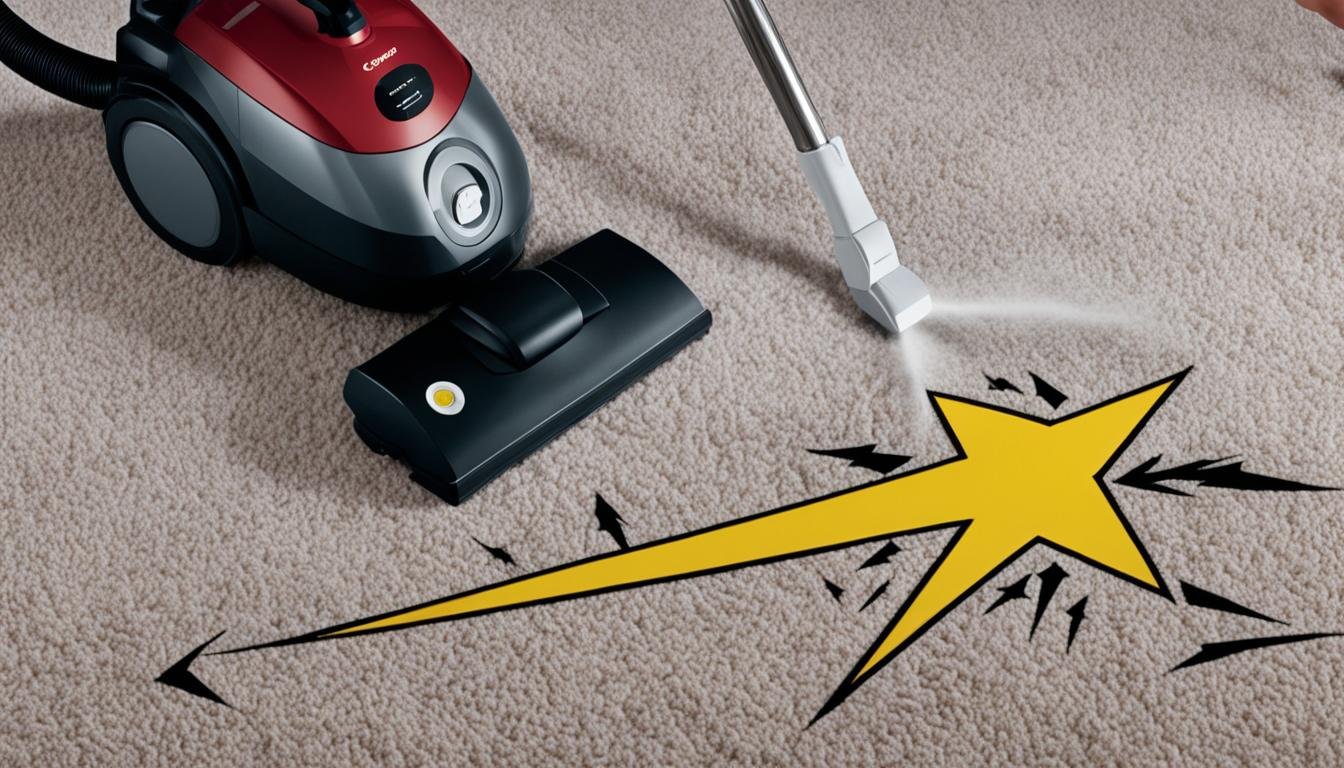Greetings! In this article, I will share some super easy tips on how to ground a vacuum cleaner. Grounding your vacuum cleaner is essential to ensure safety while using it. By following these simple steps, you can alleviate any concerns about static or electrical shocks. Let’s get started!
Key Takeaways:
- Grounding a vacuum cleaner is crucial for electrical safety.
- Following the grounding techniques mentioned in this article will help mitigate static and prevent shocks.
- Ensure you have the necessary tools, including a vacuum cleaner, an anti-static wristband, a jubilee clip, and multi-core wire.
- Join the croc clip and jubilee clip with the wire, and insert the wire into the vacuum cleaner hose.
- Clip the grounded wire securely to the vacuum cleaner’s case for a reliable connection.
How to Ground a Vacuum Cleaner? Beginner’s Guide
If you encounter common issues with your vacuum cleaner, you can troubleshoot them on your own. By addressing these issues, you can keep your vacuum cleaner running smoothly. Here are some troubleshooting tips for common problems:
Troubleshooting Vacuum Cleaner Suction Problem:
If your vacuum cleaner is experiencing a suction problem, follow these steps:
- Check the hoses, filters, and rollers for any obstructions.
- Make sure the roller spins freely.
- Inspect the hoses and nozzles for clogs.
- Clean or replace the filter if it is full or covered in dirt.
Troubleshooting Noisy Roller:
If your vacuum cleaner has a noisy roller or the roller isn’t moving properly, follow these steps:
- Inspect the belt that connects the motor to the roller.
- If the belt is cracked or broken, replace it with a new one.
Troubleshooting Vacuum Cleaner Motor Issues:
If the motor of your vacuum cleaner keeps cutting off or won’t start, follow these steps:
- Check the power cord for any damage.
- If the cord is damaged, either fix it yourself or take it to a repair shop.
If none of these troubleshooting steps resolve the issue, it is recommended to seek professional help. Addressing these common issues will help maintain the performance and longevity of your vacuum cleaner.
Comparison Table: Vacuum Cleaner Brands and Common Issues
| Brand | Common Issues |
|---|---|
| Dyson | Lack of suction power, motor overheating |
| Shark | Brush roll not spinning, clogged filters |
| Hoover | Noisy motor, belt problems |
| Bissell | Loss of suction, dirty brushes |
Understanding common issues specific to different vacuum cleaner brands can help you identify potential problems and take appropriate troubleshooting steps.
Conclusion
Ensuring the safe use of vacuum cleaners is essential for protecting yourself and your household from electrical shocks. By following the grounding tips outlined in the previous section, you can greatly reduce the risk of static and ensure a secure and safe vacuuming experience.
Grounding your vacuum cleaner not only helps prevent electrical shocks but also increases the overall safety of your cleaning routine. By taking the time to inspect and clean important components like hoses, filters, rollers, belts, and power cords, you can address common issues and maintain the performance and longevity of your vacuum cleaner.
Remember, safety should always be a top priority when using electrical appliances. By remaining vigilant and implementing proper grounding techniques, you can enjoy the benefits of a clean home without the worry of potential electrical hazards.
FAQ
How do I ground a vacuum cleaner?
To ground a vacuum cleaner, you can follow these simple steps. Gather the necessary tools including a vacuum cleaner, an anti-static wristband with a croc clip, a jubilee clip to fit the hose, and a length of multi-core wire. Strip an inch of sleeving off one end of the wire and as much as desired on the other end. Cut off the static wristband connector and join the croc clip end and the jubilee clip by wrapping the wire around them. Place the other end of the wire inside the vacuum cleaner hose, spreading out the loose wires to contact the sides of the hose. Treat the vacuum cleaner with the grounded wire as you would a normal static wristband, ensuring a secure connection by clipping it to the case. By following these steps, you can successfully ground your vacuum cleaner and alleviate any concerns about static or electrical shocks. (First source)
How can I troubleshoot common issues with my vacuum cleaner?
If you encounter common issues with your vacuum cleaner, you can troubleshoot them on your own. For a suction problem, check the hoses, filters, and rollers for obstructions. Make sure the roller spins freely and inspect the hoses and nozzles for clogs. Clean or replace the filter if it is full or covered in dirt. If the vacuum cleaner is noisy or the roller isn’t moving, inspect the belt that connects the motor to the roller. If the belt is cracked or broken, replace it with a new one. If the motor keeps cutting off or won’t start, check the power cord for any damage. If the cord is damaged, either fix it yourself or take it to a repair shop. If none of these troubleshooting steps resolve the issue, it is recommended to seek professional help. By addressing these common issues, you can keep your vacuum cleaner running smoothly. (Third source)
Why is grounding a vacuum cleaner important?
Grounding a vacuum cleaner is an important step in ensuring electrical safety and preventing shocks during use. By following the grounding tips mentioned, you can alleviate any concerns about static and increase the safety of your vacuuming routine. Additionally, troubleshooting common issues with vacuum cleaners can help maintain their performance and longevity. By inspecting and cleaning the necessary components, such as hoses, filters, rollers, belts, and power cords, you can address common problems and keep your vacuum cleaner in optimal working condition. Remember to always prioritize safety when using electrical appliances like vacuum cleaners. (Second source, Third source)





Leave a Reply